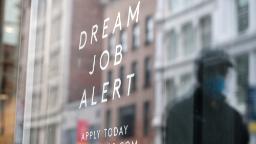The Fed could easily drive Black unemployment much higher than the overall jobless rate | CNN Business


New York
CNN
—
Millions of jobs could be on the chopping block this year, as the Federal Reserve continues its rate-hiking campaign to tame inflation. But the effects of that action likely won’t reverberate evenly across the economy.
The Fed has seen some success: Inflation has cooled for eighth consecutive months, according to the February Consumer Price Index. The Producer Price Index shows a dramatic drop in wholesale prices in February. And the Fed’s favored inflation gauge, the Personal Consumption Expenditures price index, has also started to moderate.
But the job market has proved to be a formidable force, humming steadily in the face of climbing rates meant to slow its growth. After adding more than half a million jobs in January, the US economy then added 311,000 jobs in February, with an unemployment rate of 3.6% — just above a half-century low — according to the Bureau of Labor Statistics.
However, the jobless rate isn’t expected to be that low for long.
At its most recent policy-making meeting, the Fed released projections for the year ahead that showed unemployment could jump to 4.5%, representing another 1.5 million job losses, by the end of the year.
While that’s a small improvement from the central bank’s previous 4.6% jobless rate estimate, economists say it’s possible the unemployment rate could rise above the Fed’s expectations. Moreover, they say that historically disadvantaged groups could be disproportionately affected by the central bank’s stringent monetary policy.
While some groups often sidelined in the job market have seen benefits from this hot job market — women have seen a faster pace of job gains than men in recent months, for example — others, including Black women and Latino men, have seen slower recoveries in jobless rates since the onset of the Covid pandemic.
Recession fears gained traction last month when the collapse of Silicon Valley Bank sent markets wobbling, raising concerns about the economy’s ability to handle more stress. Goldman Sachs revised its estimate of the United States entering a recession over the next 12 months to a 35% chance, up from its estimate of a 25% chance before the banking sector turmoil.
That’s of particular concern to certain demographic groups: Jobless rates for Black and Hispanic Americans often increase by more than those of their White counterparts during recessions, said Rakesh Kochhar, a senior researcher focusing on demographics and social trends at the Pew Research Center.
History makes that discrepancy clear.
A Pew Research Center report comparing two recessions in recent decades shows how Black and Hispanic Americans experience disproportionate effects on their jobless rates during periods of economic downturn. From the second quarter of 2007 to the second quarter of 2009, during the Great Recession, the unemployment rate rose 6.5 percentage points for Black Americans. The Hispanic unemployment rate climbed 6.3 percentage points. For White workers, it increased 4 percentage points.
And from the first quarter of 1990 to the first quarter of 1991, the unemployment rate climbed 1.4 percentage points for Black Americans and 2.1 percentage points for Hispanic Americans. The White unemployment rate rose 1.3 percentage points.
Economists say it’s hard to guess the trajectory of the unemployment rate this year, noting it could very well exceed the Fed’s estimate.
“There’s just tons of momentum, and once you slow the economy enough to get the unemployment rate moving up, it’s very hard to sort of turn that cruise ship back around,” said Josh Bivens, research director and chief economist at the Economic Policy Institute.
As such, the Fed’s tightening efforts could easily drive the Black unemployment rate much higher than the overall jobless rate, said William Spriggs, an economics professor at Howard University and chief economist to the AFL-CIO.
“If the Fed continues to use unemployment as its measure of labor force slack, and thinks they want a 4.5% unemployment rate — to make that happen, the Fed would have to induce net job loss in the labor market,” Spriggs told CNN in an email. “If we go through two months of negative job growth, all bets are off. The Black unemployment rate will easily get to 9% in that scenario.”
One other likely consequence of growing unemployment is slowing wage growth, Bivens said.
Like rising unemployment, stunted wage growth tends to hit marginalized groups harder. A 2021 Economic Policy Institute report shows that a 1 percentage point increase in overall unemployment correlates with about 0.5% slower wage growth for White median hourly wages. Wage growth falls by roughly 0.8% for Black median hourly wages.
“A lot of people have this idea that in a recession, if unemployment rises by a couple of percentage points, as long as you’re not one of those unlucky people to lose the job, you’ve dodged the bullet,” Bivens said. “And that’s not true at all.”
Still, a robust labor market isn’t a permanent solution to bridging employment disparities, even if the Fed does keep rates lower, says Wendy Edelberg, director of the Hamilton Project and a senior fellow in economic studies at the Brookings Institution.
The job market’s recent strength is unsustainable, she said. The US economy needs about 75,000 net job gains a month to keep stable and is currently adding about 350,000 net job gains a month on average, according to Edelberg.
“[The Fed is] right to be confident that one of the things that’s going to have to happen to get inflation back down to a normal, stable level is to get job growth to a normal, sustainable level,” Edelberg said. “But if the Fed’s actions resulted in a slower labor market, then inflation stayed high — that would be a disaster.”
The March jobs report from the Department of Labor, due to be released Friday at 8:30 a.m., is expected to show the US economy gained 240,000 positions last month. ADP’s private-sector payroll report, generally seen by investors as a proxy for the trajectory of Friday’s number, fell short of expectations, with just 145,000 jobs added. Economists had expected private hiring would rise by 200,000 positions last month.







